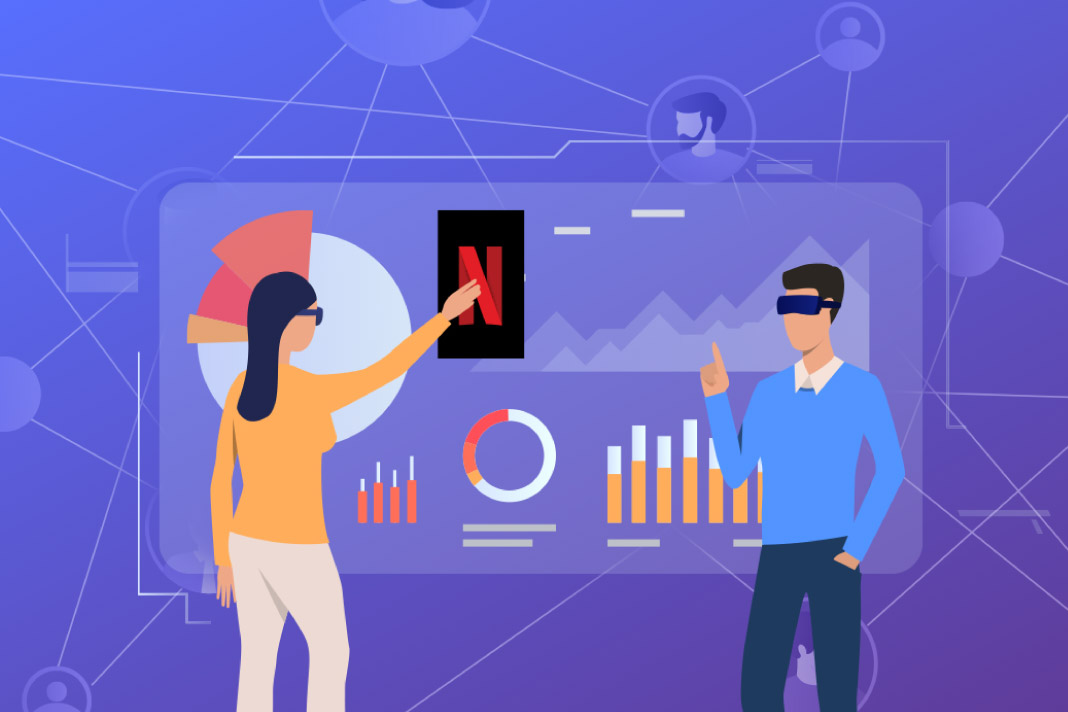From pioneering DVD rentals to dominating streaming, learn how data-driven recommendations keep viewers engaged, setting Netflix apart in the crowded video streaming landscape.
The streaming platform’s secret to personalizing viewers’ experiences lies in data-driven, AI-powered algorithms.
After a long, tiring day at work, who doesn’t want an intelligent streaming platform that understands our preferences and sets up an ideal evening viewing with minimal effort? Netflix always helps us discover our next favorite movie, series, or documentary. It does this for you, me, and millions of subscribers daily.
Though working behind the scenes, Netflix’s recommendation algorithm directly interacts with us. It’s a significant part of the platform’s digital success story and instrumental in maintaining market dominance. And why not if it can suggest precise genres like a dark thriller starring Joaquin Phoenix? A strong match to a viewer’s interests will keep them engaged.
The streaming service uses machine learning (ML) and artificial intelligence (AI) to personalize our experience in an increasingly crowded video streaming market.
Through ambitious and innovative business decisions, Netflix transformed from a DVD rental business to one of the biggest TV and movie studios in 20 years. It developed a streaming business from scratch by investing in original content creation.
Founders Reed Hastings and Marc Randolph always keenly understood the market. From the beginning, Netflix was meant to be more than an easy way to rent movies. When internet usage became mainstream, the founders saw an opportunity to decentralize entertainment. They gained a toehold in a competitive market with DVD rentals. In 1999, Netflix announced its subscription model, and since then, it has experienced consistent growth.
Netflix’s primary asset is its technology. The streaming platform uses a recommendation engine to refine the subscriber experience by providing suggestions. Developed by hundreds of engineers, it spans algorithmic approaches like neural networks, causal modeling, and matrix factorization. This tool uses data and algorithms to filter a catalog and predict the most relevant items for any viewer.
The engine analyzes all service users and recommends new users based on items relevant to other users with similar tastes. It also filters intrinsic properties of items the user has already shown interest in and the duration of a viewer’s show-watching.
Additionally, several billion ratings from its members serve as its data source, with over a million new ratings being added daily. Recently, the OTT platform incorporated users’ social data, allowing extraction of social features related to them and their friends for better suggestions.
In simple terms, the algorithm makes movie suggestions based on the subscriber’s view history and ratings given to individual titles. This instructs Netflix’s servers to process information from its databases to determine which movies a customer is likely to enjoy.
Personalization starts on its homepage, displaying videos arranged in horizontal rows, each with a title related to the videos in that group.
Apart from internal data, they also use external sources such as box office information, performance, and critic reviews.
A Netflix post titled “It’s All A/Bout Testing: The Netflix Experimentation Platform” states that the company rigorously runs A/B tests for each of its innovations and product changes before making them the default user experience. These tests present two different versions of experiences to users to gauge their reactions. On average, Netflix selects around 100,000 users to test its hypotheses. This empirical approach ensures that product changes—content, images, and videos—are driven by actual data collected from the A/B tests rather than by the most opinionated Netflix employees.
This is one reason why no two people have the same experience on its platform. Netflix has undoubtedly elevated personalizing viewing suggestions, allowing subscribers to create queues of titles to add to their viewing list. Over 77% of all content viewers watch is now from some recommendation.
A good recommendation is critical, as it motivates viewers to stick around, increases average watch time, and reduces subscriber churn rate.
Since the Netflix Prize in 2006, an ML and data mining crowdsourcing competition for new ideas on recommender systems, which ran until 2009 to improve its famous in-house recommender system, Cinematch, the streaming platform has been putting tremendous effort into optimizing its algorithm.
Netflix invested heavily in hardware and software to build the recommender system and perform large-scale analytics. According to the Netflix technology blog, engineers reported dedicating more than 2000 hours of work to build an ensemble of 107 algorithms that won them the prize. Since 2009, the algorithm has been scaled to handle its 5 billion ratings.
As its user base grows daily, especially with more people staying at home due to the ongoing pandemic—Netflix now boasts over 203 million paying members—the viewer data is helping the behemoth internet company gain more insights about viewer behavior. This further improves the accuracy of its Recommendation Engine and enables the creation of content to suit every taste.
It’s not an overstatement to say that when its personalized recommendation algorithms generate $1 billion a year in value from customer retention, Netflix is undoubtedly in it for the long haul.



